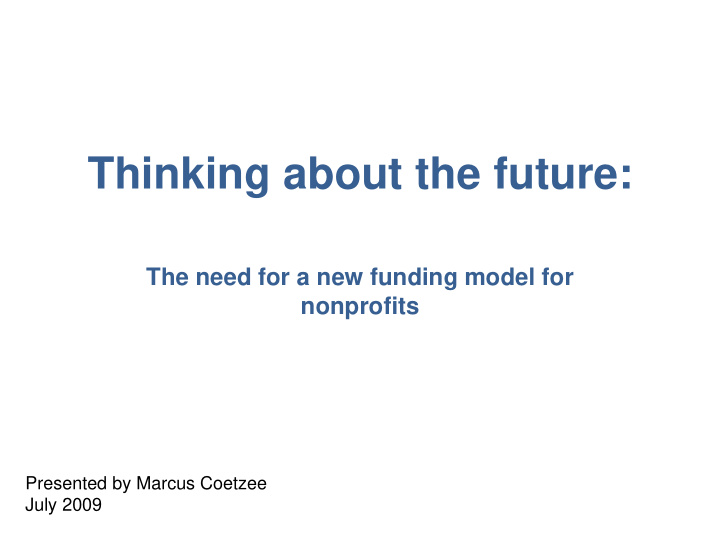



Thinking about the future: The need for a new funding model for nonprofits Presented by Marcus Coetzee July 2009
Part 1: The Problem
1. Pool of funding oversaturated www.Flickr:com : Mrr182
2. Increase in numbers of NGOs …and this was only in 1999 Size and scope of the nonprofit sector in South Africa, 2002.
3. Project funding is dangerous • What happens in the gaps between funding? • Who pays for the infrastructure needed to support projects? • How big is the profit margin? • Who pays when funding is late?
4. Financial management complicated • Multiple donors, each with their own reporting requirements • Overheads no one wants to pay for • Gaps between funding but still bills to pay • No profit margins • Separate audits and bank accounts • Restrictions on use of funding www.Flickr:com : Walwyn
5. Fraction of impact Are you having more than 10% of the impact you desire? HDI Index from WorldMapper
Part 2: Some Good Ideas
1. Change your paradigm
2. Market, don’t fundraise Abalimii • • Sell success, not problems Differentiate from competitors • • Embrace web 2.0 Grab PR opportunities • • Demonstrate impact Provide ROI to donors/investors • • Package products Develop enticing brand • Clearly define purpose and outcomes
3. Earn income, don’t beg for donations For example… Social enterprises are well-established in the United Kingdom: • 55,000 social enterprises • Turnover of £27 billion/year • Employs 5% of workforce • Government has a social enterprise strategy and department of social enterprise • Legal form for social enterprises (community interest company) • Social enterprise funds (e.g. DOH has £100 million in investment fund for social enterprises.)
4. Hunt for the profit margin! www.Flickr:com : Charles Fred
5. Explore new funding models • Sell services/products to beneficiaries (e.g. All Grameen Projects and A-Z Textiles and SoHCo Housing) • Sell services to government (e.g. TADSA and NICRO) • Increase paying membership (e.g. Fine Music Radio) • Setup/buy and use businesses (e.g. Acumen Fund) • Certify (e.g. Forestry Stewardship Council & Heart Foundation) • Increase individual donors (e.g. Doctors without Borders & Greenpeace) • Raise money from successful beneficiaries (e.g UCT Alumni) • Recycle resources (e.g. FeedBack and various community recycling co-ops) • Siphon money from businesses (e.g. Charity Wines or other cause-related marketing projects)
6. Integrate into business systems Timber Plastics recycles Green and low cost waste and employs building materials former prisoners Earns Provides income rehabilitation Fibre to Paper Mills NICRO manages rehabilitation SASOL ChemCity Enterprise development and honouring responsibilities Tetra Pak
Thank you Good fortune, and hope we have given you something to think about Marcus Coetzee www.MarcusCoetzee.co.za Marcus.Coetee@gmail.com 0828799131
Recommend
More recommend